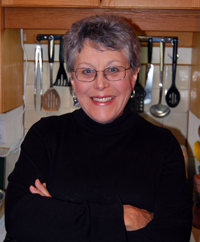

Fish story #1
“Don’t buy fresh fish further inland than a dock,” a prawn fisherman once told me. “Think about it,” he said. “Fish hauled into fishboat Thursday afternoon. Fishboat docks maybe Friday noon. Catch offloaded to a truck; travels to a warehouse. Trucked on Saturday to supermarket. Gets packaged and labeled. Saturday afternoon — maybe — it’s on the shelf. Mrs. Robinson buys it for Sunday dinner, thinking it’s fresh. By the time the Robinsons eat the fish, it’s been dead for four days and traveled who knows how far.”
“So what do we do?”
“Buy frozen. The best is frozen at sea, soon after it’s caught. It can stay frozen until an hour before you eat it.”
Fish Story #2
On a cave in the southwest is a salmon carved into the stone ceiling. Carbon dating technology puts the date of the carving at 25,000 years ago. Salmon used to abound not only in the seas but also in the rivers of Europe and the Americas, as well as in both the Pacific and Atlantic Oceans. For 25,000 years, humans have relied on fish as a major food source.
In the last 50 years, human need and greed have wiped out the cod fisheries of the Atlantic, and we are close to doing the same with the salmon fisheries on the west coast.
Fish story #3
You buy frozen fish. It’s packaged in plain plastic without ID: no country of origin, no labeling as to preservatives. Just the price sticker and weight. It’s called Black Cod.
You ask the people in the meat department where it’s from. Oops, they threw the box away. But, they say, there’ll be more on Tuesday. Come then and we’ll save you the box.
You return Tuesday. Nope, box not there. No idea really where it’s from. You press it. The helpful meat counter assistant goes backstage for fifteen minutes. You can see her on the computer. No dice: she comes back shaking her head. “We can usually find out,” she says, “but this one’s not on the list.”
You take it home anyway, cook the fish and eat it.
Meanwhile, you learn that black cod is another name for sablefish. On the list of Best Choice fish from Canada’s Seafood Guide at http://www.seachoice.org, sablefish is okay as long as it’s fished longline, and from Canada, the US or Alaska.
You never do find out where the sablefish labeled Black Cod, boxed somewhere and sold in Revelstoke, comes from.
Fish Story #4
You buy Tilapia at Costco. The label says no preservatives and states the country of origin as Ecuador. You look it up on SeaChoice website when you get home.
Whew. It’s in the yellow list, meaning there are some concerns about tilapia from Central and South America. The package is packed in Montreal by International Foods. At least it’s not from China or Japan, which are on the red AVOID list.
If we don’t take the trouble, we won’t have the choice.
Our oceans are in dire shape, with declining biodiversity, the death of coral reefs, the decline of fish stocks due to pollution, climate change, over-fishing and wasteful deep-sea trawling practices. The cod are gone, possibly forever. Salmon are endangered. Watch the dump, as I have done, of construction waste or worse into the Straight of Georgia, and you know why the oyster beds no longer thrive on Gabriola Island. Yes, we need to pay attention to the health of fish stocks and the oceans.
You can find out which fish are on the green, yellow and red lists in Canada’s Seafood Guide, published on-line at http://www.seachoice.org. SeaChoice is an organization formed by five Canadian conservation organizations — Canadian Parks and Wilderness Society, the David Suzuki Foundation, Ecology Action Center, Living Oceans Society and Sierra Club British Columbia, in collaboration with Seafood Watch, a similar organization sponsored by the Monterrey Bay Aquarium in California.
What puts some fish on the red and yellow lists? Three criteria are used by SeaChoice and its American counterpart SeaWatch:
- sustainability of the fishery
- minimizing environmental impact on the health of oceans
- management: vessel owners have signed a code of conduct indicating that they
- share information on fish stocks, for instance, and respect closed fishery notices.
You can read more about how these criteria are applied, and how fisheries are included or excluded from the green, yellow or red lists. You can print out a wallet-sized card to take shopping. The SeaChoice website also lists fish products by brand name and by supermarket availability.
As consumers, we do have the opportunity to make good choices. Yes, it’s a lot of trouble. But maybe less trouble than finding alternative sources for the goodness—protein, minerals, Omega-3 fats — that fish offer. If we don’t take the trouble, very soon we won’t have the choice.



